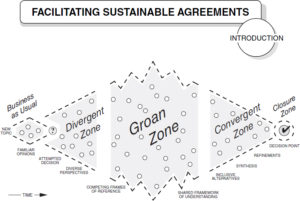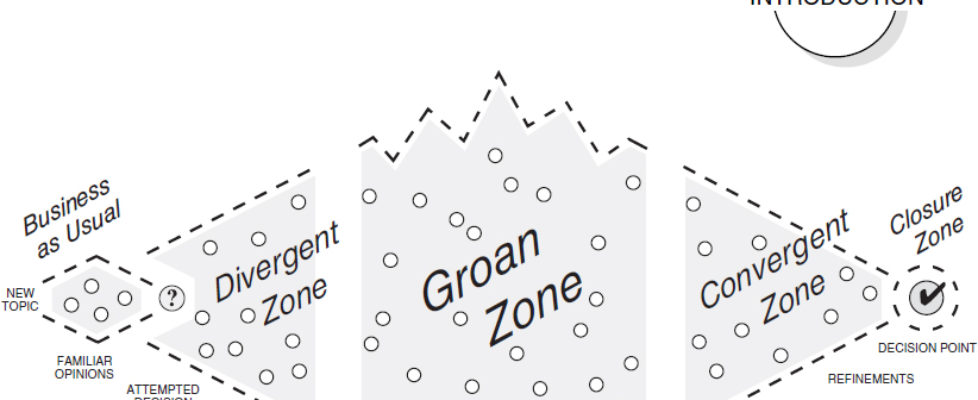The Diamond of Participation is forever OR Get your diamonds into shape

I think the diagram to the left, the Diamond of Participation, is by far the most helpful diagram for anyone interested in running better meetings that come to better decisions. I’m very grateful to the “Facilitators Guide to Participatory Decision-making” i for providing it. I’m writing this blog both to explain it and also to take issue with a couple of the bits of it.
The diamond represents a good decision-making process. You start with a clear question on the left hand side. You open up the issue. Roughly half way through, you start to narrow it down, until you make your decision at the extreme right.
My first demur is with the ‘groan zone’. In my own experience, I have hardly, if ever, found this part of a meeting to be painful. A good process for this part of a meeting is usually a lot of fun. It needs to review the ideas generated in the divergent zone and collect them into a series of options and then draw out a solution based on some or all of them. So perhaps I’d change ‘groan zone’ to ‘collection section’.
Secondly, I’m not keen on the ‘Business as Usual’ part of the diagram. Since the horizontal dimension is time, it looks as if this only takes about ten minutes. In my experience, meetings that go wrong take at least as much time as meetings that go right, and often longer. There are two ways in which they can go wrong, shown in the two diagrams below. In the first case, the meeting is never opened up, perhaps because the chair has kept too tight a grip. It’s likely to be pretty boring, since all that is happening is the rehashing of the status quo. The second case is the opposite. There is only opening up, only divergence, and no closing down. There will either be no decision, or it will be arbitrary. In both cases, any decision that is made is unlikely to reflect the values, interests, knowledge and ideas of the participants.

This blog post is based on a guide to decision-making that Perry is writing, to be published by Rhizome later in the year. Email perry@rhizome.coop if you would like to be told when it comes out.
i Sam Kaner et al, Facilitators Guide to Participatory Decision-making, Jossey-Bass, San Francisco, USA, 2007, page 20


August 22, 2016 @ 4:44 pm
I wonder if instead of ‘closing down’, you might frame it as searching for synthesis, or creating synthesis. I think closing down seems a little contrary to the spirit of facilitation.
September 19, 2016 @ 3:01 pm
good point! Thanks Carl
September 8, 2016 @ 1:39 am
Many thanks for this! I really like your variations on the diamond.
The triangle is certainly something I see many rookie facilitators struggle with – going broader and and broader and not being able to move to synthesis. This goes hand in hand with short timeframes – not allowing enough time means finishing at the broadest point. I’ve seen the impact of this on activist groups trying to implement a ‘strategy’ which has way too many threads, because they weren’t able to move into prioritising and culling.
I also really appreciate the squished diamond, so often seen in overly controlled meetings, groups with power dynamics which marginalise or silence participants with different ideas, or approaches that crush creativity.
I’m running a facilitation training soon, I’ll share the diagram and updates and see how ppl respond. All the best to you all
December 12, 2016 @ 11:40 am
Hi Holly,
Thanks for your thoughts. In terms of simple logic, I guess that the answer has to be one of:
* More time (longer meeting/another meeting)
* Moving on to the right hand side earlier on in the meeting
* Prioritising, but then only planning with the top one or two ideas in detail
* Doing some of this outside the meeting (left hand side beforehand/right hand side afterwards)
I’d be interested to know which of these are favoured by the people who come to your training.
Forza
Perry
Facilitating meetings: the middle game - Rhizome
October 26, 2017 @ 11:25 am
[…] tries to go beyond ‘business as usual; read more about this and participatory decision-making here. Some years back we published a blog post about what to do at the beginning of a meeting, but […]